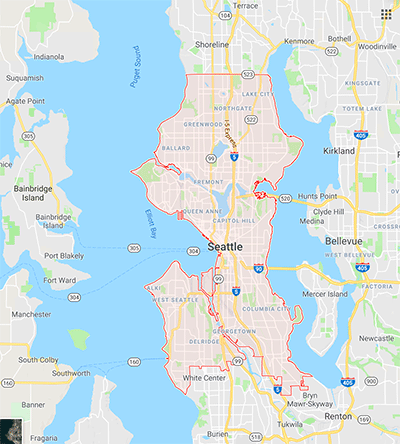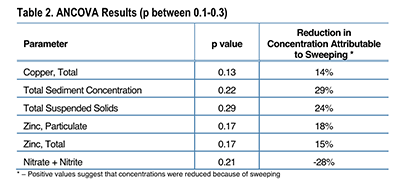Seattle Report Catalogs Street Sweeping Effectiveness |
by Ranger Kidwell-Ross 
The City of Seattle, Washington, faces what might be called a "double whammy" when it comes to preserving water quality in its area. That's because the city is perched on two large bodies of water, Puget Sound and 34 square mile Lake Washington. In an effort to better eliminate pollutant runoff from its streets, Seattle city managers doubled their street sweeping program for 2016. This article and the linked study results outline the results received.The City of Seattle's "Street Sweeping Water Quality Effectiveness Study Final Report" offers an in-depth insight into how the City's sweeping program appears to be impacting water quality in the region. Our coverage includes a link to the Study, which is located at the end of this article. From October 2014 through September 2016, Seattle Public Utilities (SPU) conducted water quality monitoringto evaluate the effectiveness of street sweeping on urban stormwater runoff. This intent of the study was to help add to the limited data available about modern street sweeping technology’s effect on stormwater quality.
Stormwater monitoring was conducted at four sites located on the same arterial street in the southern portion of the city. Two sites were designated as control sites: These were swept on a weekly basis, which is the normal condition for Seattle's arterial roadways. The other two sites served as "Impact Sites" and were not swept in 2016. The four sites were monitored over a two-year period from 2014 to 2016. In 2014-2015 all four sites were swept on a weekly basis. However, in 2015-2016 two of the sites were swept weekly (termed the 'Control sites') and sweeping at the two 'Impact Sites' was discontinued three months before the year two sampling commenced in order to Sweeping was discontinued at the Impact Sites approximately three months before sampling commenced to allow for street dirt accumulation and equilibration to unswept conditions at the Impact Sites. The sampling methodology is discussed in detail in the study itself so you will want to read it if you have more interest. We will only discuss the more interesting results in this article. The changes measured for particulate copper (17 percent concentration reduction). The runoff of the coarsest sediment size fraction >500 microns (um). These particles that were of >0.019685 inch in diameter were reduced by 64% as a result of sweeping. For particles between 250 and 500 um, which is to say from 0.00984252 inch to 0.019685 inch in diameter were reduced a total of 48 percent. The change measured for the finest sediment size fraction (<3.9 um/<0.000153543 inch), which is considered clay/colloidal range, was negative. The inference is that street sweeping may increase the concentration of the finest particles in stormwater runoff. Although the study did not speculate on the reasons for this, my own three decades of reading and experience suggests this may be as the result of the sweeper's removal of the 'deposition layer' of packed-down dirt on a roadway that is uncovered during sweeping. This allows the finest small-micron particles to be more available to runoff via a rain event and/or to be entrained into the atmosphere by wind events.
Table 1 illustrates the findings detailed above:

When evaluating environmental data, a p-value of 0.1 is typically the highest cutoff for statistical significance. However, due to the problems of variability and the small sample size in this study, the City also presented parameters between 0.1 and 0.3 to suggest the impact street sweeping might make if a larger data set were available. As shown by Table 2, this would predict results as follows:
Table 2 illustrates the findings detailed above:

The basic conclusion reached in the study was an indication that street sweeping is an effective stormwater BMP in addition to providing multiple other city-wide benefits that were not evaluated as part of the study. According to our contact at the City of Seattle, Shelly Basketfield, at the end of March 2019 the City will present a report to support its 'Plan to Protect Seattle's Waterways.' This will include further analysis intended to tie the information gathered in the study outlined in this article to actual program results, including their analysis of what the study results really mean. WorldSweeper has been promised an in-depth interview with Basketfield and/or other leaders in Seattle's stormwater pollution reduction team at that time. We invite you to view in its entirety the City of Seattle's "Street Sweeping Water Quality Effectiveness Study Final Report, 2018." You may reach Shelly Basketfield via email sent to Shelly.Basketfield@seattle.gov. |
© 2005 - 2022 World Sweeper
|
Street Contents
|